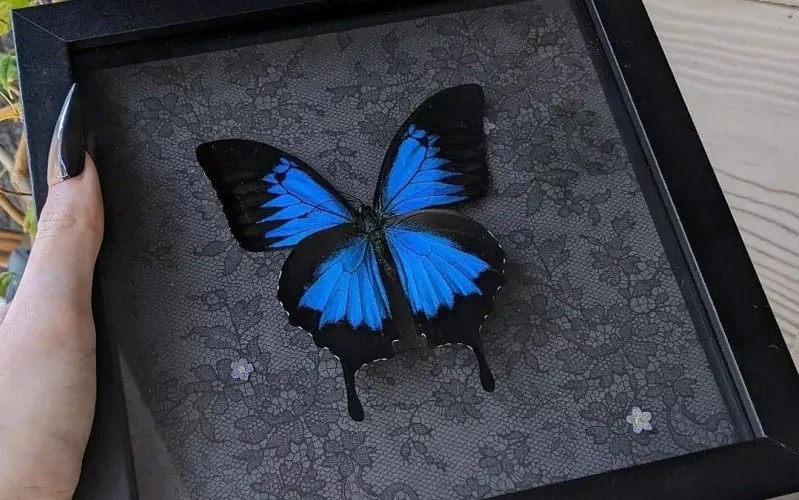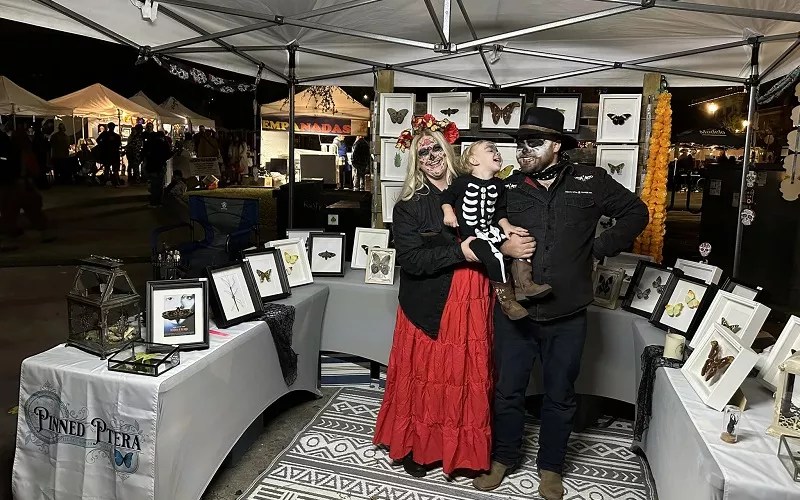
Lily Lurid

Audio By Carbonatix
Move over “Live Laugh Love” sign and “Tournée du Chat Noir” poster. More and more people want dead bugs on their walls, albeit in tasteful frames and poses. That’s what Morgan Loftin reports. She and her husband Micah run Pinned Ptera, a company in Denton that specializes in pinned butterfly specimens. The couple are homeowners, solid citizens and Christians. They just happen to love butterflies and make a living mounting dead ones for sale.
Surprisingly, they have an equally mainstream clientele.
“I don’t think we need to bejewel them or add bones or make it dark,” says Loftin. “They are so beautiful that you can appreciate them in a scientific way. We get clients that are gothic and witchy, and they’ll buy a huge beetle, death’s head moth or a spider because they like our simple style. We also get, like, Chip and Joanna Gaines modern farmhouse types that want a white frame that can go anywhere.”
The Loftins’ style is quite modernist. They highlight the beauty of their insects, mostly butterflies, with simple white or black frames. The stark settings allow the colors of the animals to shine through. Even comparatively drab insects like stick bugs look vibrant, set against snow-white panels.
An appreciation for natural beauty is what got the Loftins interested in the first place. In February 2021, they were visiting a butterfly conservatory in the Florida Keys when a butterfly landed on Morgan, and she fell in love with it. When they exited the gift shop, a variety of mounted insects were available to sell, but not this specific species. Undeterred, Micah identified the butterfly online and ordered one from Europe. Unfortunately, it arrived simply folded up in a box, nothing more than a carefully packed corpse with little of the majesty left.
“Micah started watching YouTube videos about insect taxidermy and presented it to me,” says Loftin. “He was so proud.”
Morgan Loftin had always been crafty, and with Micah’s newfound knowledge, they made a few more framed butterflies to sell at the Denton Community Market. She didn’t expect much.
“If we sold five, we’d break even,” she says. “Instead, we sold out!”

Morgan (left) and Micah Loftin selling insect taxidermy at the 2021 Denton Day of the Dead festival.
Kadean Long
Another person who has noticed the thirst for insect taxidermy from mainstream buyers is Lily Lurid. She is probably what most people picture when they think about the kind of person who works with dead bugs for fun and profit. Ghostly pale with wild hair, she works as a gothic and darkwave radio host on KNON 89.3 FM and acts in thriller short films such as Broken.
Lurid started mounting insects in 2018, focusing mostly on spooky dioramas and elaborate displays with a Victorian edge. Being so well connected to the local goth scene, many of her early clients came from her own social media followers. Quickly, though, she noticed that she was getting suburban professionals and other people from outside the subculture.
“I was surprised,” Lurid says. “When I first started, my themes were really gothic and creepy because that’s what I had been exposed to. It’s how I came to know it. But there are so many people that want just a plain white background and hang it in a lawyer’s office.”
Why has the market for insect taxidermy grown so suddenly? Lurid thinks it may have something to do with the plague. Over a million Americans died during the COVID pandemic. For years, everyday life was changed to deal with an omnipresent and invisible threat of death. Insects are often associated with dying and decay, so it stands to reason that transforming their dead bodies into something beautiful might have an appeal following the trauma of the epidemic.
“I think it gives people more of a moment to think about death, to look at what it is,” says Lurid. “There are so many stories that live on through art.”
That’s not to say she never gets weird requests. A recent client asked her to mount a rhinoceros beetle holding a tiny knife over a blood-splattered white background. She did it, crafting a tiny blade out of modeling clay. She has also been asked to spell out messages with multiple dead beetles.
Both the Loftins and Lurid carefully source their specimens. They come from registered breeders who raise the insects to adulthood and ship them only after they die of natural causes. It can be a lot of paperwork and loss. Morgan estimates that up to 20% of her stock is unusable because of scars and tears in wings because the animals lived full lives rather than dying just to create art.
The Loftins went full-time in 2022, thanks to the growing market for insect taxidermy. They’ve also branched out into reptiles. Currently, their dream is to build their own butterfly conservatory in Denton. It would be a place to see insects live and thrive, and it would offer a small gift shop for their preserved specimen work.
Another dream for Morgan Loftin would be to open their own insect zoo. More than anything, she sees their work as adding to humanity’s appreciation for nature. A significant number of her clients are educators who use the mounted insects to illustrate anatomy to students and visitors.
“We want to have people leave us empowered with a lot of knowledge,” she says. “People need to know how important these animals are as pollinators.”
Meanwhile, Lurid continues to pursue her business as only one of her many different projects. She loans displays out on consignment to help North Texas shops such as Hearth Wisdom in Arlington-Pantego and Mystic Crystal Chaos in Plano bring in customers. She wishes she could work with more arthropods like centipedes, which are her favorite, but the mainstream market isn’t quite ready to embrace that yet.
“I absolutely love them, but I don’t get to do them as much as I would like because they’re a little creepy for most people,” she says.